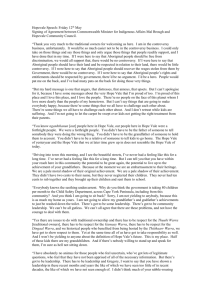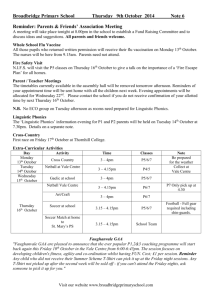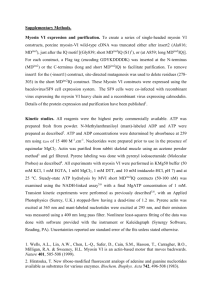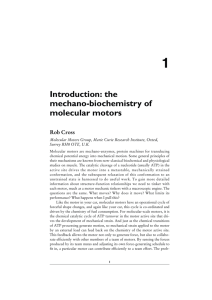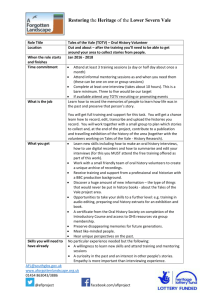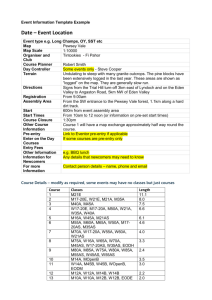Behind the Movement
advertisement
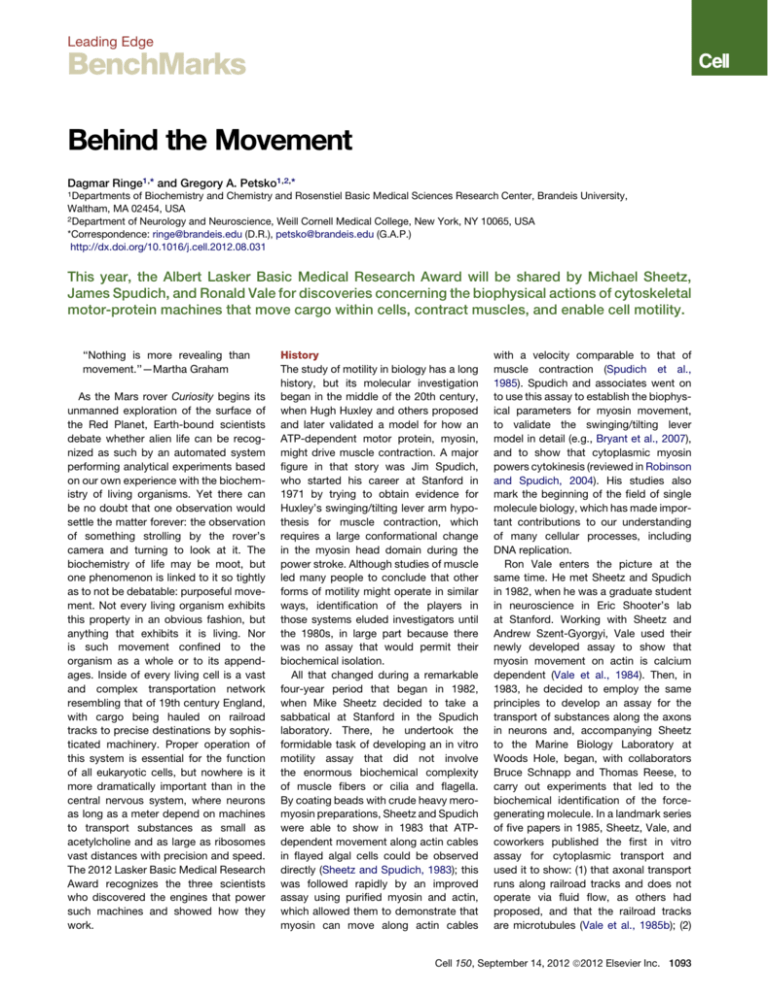
Leading Edge BenchMarks Behind the Movement Dagmar Ringe1,* and Gregory A. Petsko1,2,* 1Departments of Biochemistry and Chemistry and Rosenstiel Basic Medical Sciences Research Center, Brandeis University, Waltham, MA 02454, USA 2Department of Neurology and Neuroscience, Weill Cornell Medical College, New York, NY 10065, USA *Correspondence: ringe@brandeis.edu (D.R.), petsko@brandeis.edu (G.A.P.) http://dx.doi.org/10.1016/j.cell.2012.08.031 This year, the Albert Lasker Basic Medical Research Award will be shared by Michael Sheetz, James Spudich, and Ronald Vale for discoveries concerning the biophysical actions of cytoskeletal motor-protein machines that move cargo within cells, contract muscles, and enable cell motility. ‘‘Nothing is more revealing than movement.’’—Martha Graham As the Mars rover Curiosity begins its unmanned exploration of the surface of the Red Planet, Earth-bound scientists debate whether alien life can be recognized as such by an automated system performing analytical experiments based on our own experience with the biochemistry of living organisms. Yet there can be no doubt that one observation would settle the matter forever: the observation of something strolling by the rover’s camera and turning to look at it. The biochemistry of life may be moot, but one phenomenon is linked to it so tightly as to not be debatable: purposeful movement. Not every living organism exhibits this property in an obvious fashion, but anything that exhibits it is living. Nor is such movement confined to the organism as a whole or to its appendages. Inside of every living cell is a vast and complex transportation network resembling that of 19th century England, with cargo being hauled on railroad tracks to precise destinations by sophisticated machinery. Proper operation of this system is essential for the function of all eukaryotic cells, but nowhere is it more dramatically important than in the central nervous system, where neurons as long as a meter depend on machines to transport substances as small as acetylcholine and as large as ribosomes vast distances with precision and speed. The 2012 Lasker Basic Medical Research Award recognizes the three scientists who discovered the engines that power such machines and showed how they work. History The study of motility in biology has a long history, but its molecular investigation began in the middle of the 20th century, when Hugh Huxley and others proposed and later validated a model for how an ATP-dependent motor protein, myosin, might drive muscle contraction. A major figure in that story was Jim Spudich, who started his career at Stanford in 1971 by trying to obtain evidence for Huxley’s swinging/tilting lever arm hypothesis for muscle contraction, which requires a large conformational change in the myosin head domain during the power stroke. Although studies of muscle led many people to conclude that other forms of motility might operate in similar ways, identification of the players in those systems eluded investigators until the 1980s, in large part because there was no assay that would permit their biochemical isolation. All that changed during a remarkable four-year period that began in 1982, when Mike Sheetz decided to take a sabbatical at Stanford in the Spudich laboratory. There, he undertook the formidable task of developing an in vitro motility assay that did not involve the enormous biochemical complexity of muscle fibers or cilia and flagella. By coating beads with crude heavy meromyosin preparations, Sheetz and Spudich were able to show in 1983 that ATPdependent movement along actin cables in flayed algal cells could be observed directly (Sheetz and Spudich, 1983); this was followed rapidly by an improved assay using purified myosin and actin, which allowed them to demonstrate that myosin can move along actin cables with a velocity comparable to that of muscle contraction (Spudich et al., 1985). Spudich and associates went on to use this assay to establish the biophysical parameters for myosin movement, to validate the swinging/tilting lever model in detail (e.g., Bryant et al., 2007), and to show that cytoplasmic myosin powers cytokinesis (reviewed in Robinson and Spudich, 2004). His studies also mark the beginning of the field of single molecule biology, which has made important contributions to our understanding of many cellular processes, including DNA replication. Ron Vale enters the picture at the same time. He met Sheetz and Spudich in 1982, when he was a graduate student in neuroscience in Eric Shooter’s lab at Stanford. Working with Sheetz and Andrew Szent-Gyorgyi, Vale used their newly developed assay to show that myosin movement on actin is calcium dependent (Vale et al., 1984). Then, in 1983, he decided to employ the same principles to develop an assay for the transport of substances along the axons in neurons and, accompanying Sheetz to the Marine Biology Laboratory at Woods Hole, began, with collaborators Bruce Schnapp and Thomas Reese, to carry out experiments that led to the biochemical identification of the forcegenerating molecule. In a landmark series of five papers in 1985, Sheetz, Vale, and coworkers published the first in vitro assay for cytoplasmic transport and used it to show: (1) that axonal transport runs along railroad tracks and does not operate via fluid flow, as others had proposed, and that the railroad tracks are microtubules (Vale et al., 1985b); (2) Cell 150, September 14, 2012 ª2012 Elsevier Inc. 1093 that the transport along single motor proteins to move synmicrotubules is bidirectional aptic cargo to their specific (Schnapp et al., 1985); (3) sites of action along both that a single protein, which microtubules (where the could be isolated from either motors are both kinesin and squid or mammalian brain dynein, depending on the and was later dubbed kinesin, direction of motion) or actin was sufficient to power this filaments (where the motor is transport in an ATP-depencytoplasmic myosin). These dent manner (Vale et al., mechanisms are crucial both 1985c); (4) that kinesin-powfor synaptogenesis and for ered transport operates solely activity-dependent changes in the plus-end direction in synaptic strength during (toward the nerve terminal) plasticity. (Vale et al., 1985a); (5) and Much also remains to be that minus-end motion from learned about dynein and the the terminal toward the cell way that it is regulated. In body requires a different contrast to the relatively simFigure 1. A Kinesin Motor Protein Carries a Vesicle along a Micromotor protein that has the ple structure of kinesin, the tubule properties of the microtudynein motor proteins typiStill image taken from ‘‘The Inner Life of the Cell’’ (http://multimedia.mcb. harvard.edu/). Animation conception and scientific content by Alain Viel and bule-binding protein dynein cally have six tandemly linked Robert A. Lue. Animation by John Liebler/XVIVO. (Vale et al., 1985d). One may so-called AAA+ (ATPases assume that Vale’s Ph.D. associated with diverse celdefense, which occurred that same year, ization, ribosome transport for local lular activities) domains arranged in a was a relatively painless affair. protein synthesis, the transport of whole ring, a long N-terminal tail, and a coiledVale went on, as an independent inves- mitochondria, chromosome movement, coil stalk. Cytoplasmic dyneins function tigator, to develop a complete struc- microtubule dynamics, and the transport as individual homodimers and, as noted tural model for kinesin action. Together of viruses within their host cells. above, are responsible for minus-endwith UCSF colleague Bob Fletterick, he Much has also been learned about the oriented transport along microtubules. worked out the three-dimensional struc- molecules that regulate these motors. A But there are also axonemal dyneins, ture of kinesin by X-ray crystallography family of small GTPases, the Rab pro- found in flagella and cilia, that are and showed that it is similar to the teins, which were initially identified in the anchored in arrays to peripheral microtustructure of myosin (Kull et al., 1996). He late 1980s, has emerged as master bules by their N-terminal tails and then joined with Ron Milligan to use regulators of intracellular trafficking pro- generate sliding motions of adjacent electron microscopy to determine how cesses in eukaryotic cells. Rab proteins microtubule doublets toward the plus kinesin binds to tubulin and how its nucle- cycle between distinct conformations end. It appears that the coiled-coil stalk otide-dependent conformational change that are dependent on their guanine- transmits conformational information powers its movement (reviewed in Vale nucleotide-bound status: an active (GTP- between the AAA+ domains and the and Milligan, 2000). More recently, he bound) state, in which they localize to the microtubule-binding domain. In the dyhas turned his attention to dynein, a cytosolic face of specific membranes nein arrays, a number of isoforms of much larger motor protein about which and recruit downstream effector pro- axonemal dyneins are integrated to much less is known. He has determined teins, which include microtubule-bound generate the bending motions of the structures of its tubulin-binding domain kinesin and cytoplasmic dynein motor flagella and cilia filaments. and its motor domain, which have begun complexes. Other Rabs associate with A crystal structure of an ‘‘ATP-bound’’ to shed light on how ATP hydrolysis microtubule-based motors via adaptor and/or ‘‘ADP-Pi-bound’’ state will be powers its retrograde transport function proteins that simultaneously interact with needed to reveal the key ‘‘prestroke’’ (Carter et al., 2011). both the GTP-bound Rab and specific conformation of dynein; the current strucmotor complexes. Binding to Rab pro- tures are of the ADP (Dictyostelium) and The Field Today teins initiates a series of intracellular traf- nucleotide-free (yeast) ‘‘post-stroke’’ With the advent of complete genome ficking steps, including vesicle motility. states. Information on both the pre- and sequencing, the general importance of Figure 1 shows an artist’s conception of post-powerstroke conformations will be the work of Sheetz, Spudich, and Vale a kinesin motor protein walking a large essential for understanding the motility has become even more evident. For ex- Rab-bound vesicle along a microtubule cycle of dynein, as it has been for myosin. ample, the kinesin superfamily in humans railroad track. But, as Cho and Vale point out in a recent encompasses 45 distinct motor proteins. But kinesins are far from the whole review (Cho and Vale, 2012), there are These molecules power not just axonal story. In the central nervous system alone, likely to be many more important contransport, but also, among other things, the formation of new synapses requires formations to investigate, as dynein has vesicle trafficking, messenger RNA local- active transport driven by molecular three other nucleotide-binding sites in 1094 Cell 150, September 14, 2012 ª2012 Elsevier Inc. addition to the main ATP hydrolysis site. Variations in the nucleotide state of these sites may well change the conformation of the AAA+ ring. The current model for dynein function also requires more direct data to establish precisely what conformational changes occur during dynein’s ATPase cycle. Structural studies of the dynein stalk will likely provide new insight into how coiled coils are used in biological systems. Computational studies as well as direct experimental observation of the conformational changes will be important next steps, as will studies of the possible role of random, diffusional motions of the head relative to the other domains. Of course, eventually, it will also be necessary to work out the structure and dynamics of the dynein holoenzyme as it exists in the cell. Several studies have already started to dissect how newly discovered dynein adaptor proteins such as Lis1 and dynactin regulate dynein’s ATPase activity and processivity. Also, there are important studies ongoing concerning the myosin motor and its mechanism, both in muscle contraction and inside of the cell. Spudich and coworkers have shown that the stroke size varies with the type of myosin, from 10 nm for myosin II to 36 nm for myosin VI (the only myosin that moves in the minus-end direction; for example, Bryant et al., 2007). The force generated by a single myosin molecule is impressive: 5 pN or more. Some myosins have a lever arm swing of about 70 degrees, but others, despite having a short canonical lever arm, swing through an angle of almost 180 degrees. Some, like myosin V and VI, are processive, whereas others, such as myosin II, appear not to be. It seems that, at least for myosin V, when the lever arm stroke is completed, the trailing head of the two-headed molecule searches for the next actin-binding site by free diffusion. X-ray diffraction studies, not only of myosin itself (first by Ivan Rayment’s lab and then by the groups of Carolyn Cohen and Anne Houdusse), but also of intact muscles and single muscle fibers with permeabilized membranes have revealed the structural changes that underlie force generation and work production by this motor. The general structural features of the motor domain are now well established, as is a subset of the structural changes that occur during the actin-myosin catalytic cycle (reviewed in Sweeney and Houdusse, 2010). Not yet visualized are the structural rearrangements triggered by actin binding and the way that they are coupled to force generation and product release. Time-resolved low-angle X-ray diffraction on contracting muscle fibers using synchrotron radiation sources has also been used recently (by Hugh Huxley and others; see Huxley, 2004) to follow movement of myosin heads with both temporal and spatial resolution under near physiological conditions. Motor proteins have also been shown to play important roles in human disease. Mutations in kinesins cause inherited neuropathies such as Charcot-Marie Tooth disease, as well as some kidney diseases, and mutations in myosin or its binding proteins often lead to severe myopathies, including familial hypertrophic cardiomyopathy, an autosomal dominant disorder that can cause sudden death in young athletes. Dynein deficiencies give rise to chronic infections of the respiratory tract due to cilia dysfunction. Drugs that target kinesin are under development for cancer chemotherapy, and myosin-targeting drugs are being tested in the clinic for heart disease. Final Thoughts There are a number of morals from this story, not the least of which is the importance of a good biochemical assay. The power of fluorescent-labeling and multiphoton microscopy has tended to shift the emphasis in cell biology away from in vitro biochemical studies toward direct observation in living cells. Though this is clearly valuable, it is good to remember how much progress can be made in unraveling the details of a complex system if it can be replicated in such a way that its parts can be identified and their functions studied in relative isolation. The 2012 Lasker Award to Michael Sheetz, James Spudich, and Ronald Vale is a testimony to what can be learned by developing the right assay and following where it leads. Galileo Galilei, after being forced to recant his belief that the Earth moves around the sun, is said to have muttered ‘‘Eppur si muove’’—‘‘And yet, it moves’’ —as he was led away to house arrest. It was Galileo, of course, who first used a telescope to observe the Red Planet and later made precise measurements of the changes in the distance of Mars from the Earth to support his claim that the planets revolve around a fixed point that is not the Earth. Curiosity will probably not be fortunate enough to observe a Martian moving past its camera lens, but if we were able to look inside even the most primitive unicellular extraterrestrial organism, the odds are we would see that ‘‘and yet, it moves.’’ Moreover, that movement would be not just the Brownian motion of individual particles but, rather, purposeful movement along specific tracks to specific destinations. And behind the movement will be motors. Sheetz, Spudich, and Vale opened the door to a more detailed understanding of how the motors that power such movement in earthly cells perform this remarkable and essential job. REFERENCES Bryant, Z., Altman, D., and Spudich, J.A. (2007). Proc. Natl. Acad. Sci. USA 104, 772–777. Carter, A.P., Cho, C., Jin, L., and Vale, R.D. (2011). Science 331, 1159–1165. Cho, C., and Vale, R.D. (2012). Biochim. Biophys. Acta 1823, 182–191. Huxley, H.E. (2004). Philos. Trans. R. Soc. Lond. B Biol. Sci. 359, 1879–1882. Kull, F.J., Sablin, E.P., Lau, R., Fletterick, R.J., and Vale, R.D. (1996). Nature 380, 550–555. Robinson, D.N., and Spudich, J.A. (2004). Curr. Opin. Cell Biol. 16, 182–188. Schnapp, B.J., Vale, R.D., Sheetz, M.P., and Reese, T.S. (1985). Cell 40, 455–462. Sheetz, M.P., and Spudich, J.A. (1983). Nature 303, 31–35. Spudich, J.A., Kron, S.J., and Sheetz, M.P. (1985). Nature 315, 584–586. Sweeney, H.L., and Houdusse, A. (2010). Annu. Rev. Biophys. 39, 539–557. Vale, R.D., and Milligan, R.A. (2000). Science 288, 88–95. Vale, R.D., Reese, T.S., and Sheetz, M.P. (1985a). Cell 42, 39–50. Vale, R.D., Schnapp, B.J., Reese, T.S., and Sheetz, M.P. (1985b). Cell 40, 449–454. Vale, R.D., Schnapp, B.J., Reese, T.S., and Sheetz, M.P. (1985c). Cell 40, 559–569. Vale, R.D., Schnapp, B.J., Mitchison, T., Steuer, E., Reese, T.S., and Sheetz, M.P. (1985d). Cell 43, 623–632. Vale, R.D., Szent-Gyorgyi, A.G., and Sheetz, M.P. (1984). Proc. Natl. Acad. Sci. USA 81, 6775–6778. Cell 150, September 14, 2012 ª2012 Elsevier Inc. 1095

